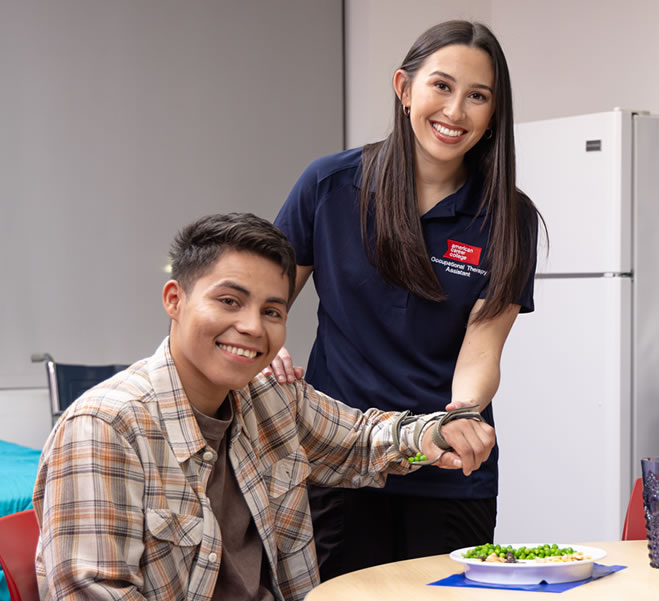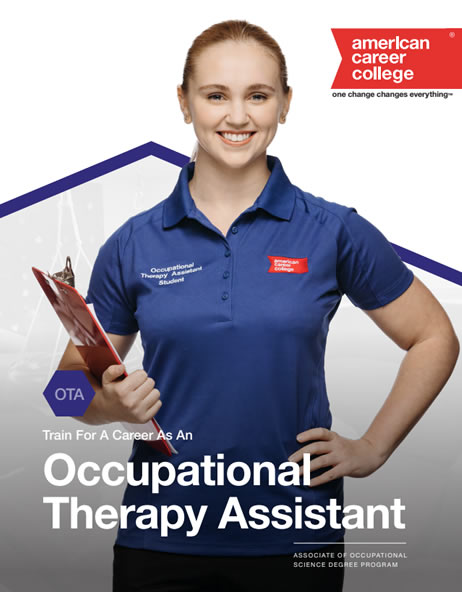| ANAT206 |
Anatomy and Physiology for Rehab Professionals ‡ |
60 | 0 | 4.0 |
This course is a continuation of ANATOMY 200, designed for the student in the rehab profession, with a focus on the muscloskeletal and nervous systems. In this course, students will further explore body tissues, the nervous system and the skeletal and muscular systems in depth. This will ensure the students are well prepared for what they may encounter in the clinical setting and be able to identify specific bones and muscles, including their origin, insertion, and innervation. |
| OTA100 |
Principles of OT |
20 | 0 | 2.0 |
This course presents an introduction to occupational therapy, including the historical development, philosophy, models of practice, theoretical concepts, and the influence of socioeconomic status and ethnicity on occupational performance. Emphasis is on the roles of the occupational therapy assistant. Topics include the role of occupations and activities in daily life and health and wellness; education and functions of occupational therapy professionals in the US and abroad; an introduction to the Occupational Therapy Practice Framework III (OTPF III) as it applies to clients and influences practice; current health care environment and the emphasis on client participation. |
| HP205 |
Professional Communication for Health Professionals ‡ |
50 | 0 | 3.0 |
Professional Communications for the Health Professionals prepares students to produce verbal and written communications appropriate to practice environments and community. Emphasis is placed on communicating in a manner that is sensitive to age, gender, culture and/or socioeconomic status. The course further expands on the importance of communicating to the client and public the value of occupation in the achievement of health that was introduced in Principles of Occupational Therapy. Documentation skills in OTA200 and OTA210 are introduced in are further developed, incorporating commonly accepted medical terminology and occupational therapy language. |
| OTA130 |
Conditions in Occupational Therapy I ‡ |
60 | 0 | 4.0 |
This course is the first in a series of two courses that apply knowledge of conventional anatomy and physiology as a basis for understanding how disease and injury are disruptors for occupational performance; this course focuses on pediatric and mental health conditions. Emphasis is placed on the clients' experience of the disease or injury (client-centered) and how that influences the quality and degree to which they are able to engage in daily occupations, while also addressing underlying neurological mechanisms where relevant. Students will be introduced to therapy interventions and learn the role of OT practitioners in the management of disease. Students will begin to build the research skills that will help identify evidence-based OT interventions associated with specific pathologies. Attention to infection control and treatment techniques related to each condition will be emphasized. |
| OTA170 |
Conditions in Occupational Therapy II ‡ |
60 | 0 | 4.0 |
This course is the second in a series of two courses that apply knowledge of conventional anatomy and physiology as a basis for understanding how disease and injury are disruptors for occupational performance; this course focuses on physical conditions. Emphasis is placed on the clients' experience of the disease or injury (client-centered) and how that influences the quality and degree to which they are able to engage in daily occupations, while also addressing underlying neurological mechanisms where relevant. Students will be introduced to therapy interventions and learn the role of OT practitioners in the management of disease. Students will begin to build the research skills that will help identify evidence-based OT interventions associated with specific pathologies. Attention to vital signs assessment and treatment techniques related to each condition will be emphasized. |
| OTA200 |
Therapeutic use of Occupations ‡ |
60 | 0 | 4.0 |
This course builds on foundational concepts introduced in OTA 100. The OTPF 3rd ed. is explored as a tool to understand occupation, occupational performance and engagement. Occupational and activity analysis methods are introduced and applied to occupations representing lifespan periods. Teaching-learning principles and techniques and the role of practice models, frames of reference, and evidence-based practice are incorporated into learning activities. Introduction to professional documentation and official documents informing OT practice are covered. |
| OTA210 |
Human Structure and Function in Occupational Therapy ‡ |
60 | 0 | 4.0 |
This course uses the knowledge gained from anatomy and physiology and applies it to the physiological and mechanical principles of movement, specifically during occupational performance. This will include the study of the function of the skeletal, muscular and neuromuscular systems during normal performance and how pathology of these systems impacts the performance of occupations. The OTPF III will be emphasized as it pertains to client factors. In total, over the term, the student will have 60 contact hours. |
| MDTR400 |
Medical Terminology † |
10 | 0 | 1.0 |
This course is an introduction to basic medical terminology and prepares students for more advanced coursework in subsequent courses such as microbiology, pathophysiology, and pharmacology classes by providing an introduction to general medical terminology. Students will study the roots, prefixes, suffixes, and abbreviations as well as general terms and their appropriate usage in medical practice. |
| OTA220 |
Group Dynamics and Leadership ‡ |
30 | 0 | 2.0 |
This course emphasizes experiential learning and understanding of group dynamics. The focus is placed on group process, group roles, and the relationship of the self to the group. Concepts taught include group development, roles and functions of groups, decision making, followership, leadership, conflict resolution, negotiation, and relational communication. Students will learn about frames of reference and practice models used to plan and lead therapeutic groups designed for varied client populations. |
| OTA225 |
Introduction to Fieldwork |
20 | 0 | 1.0 |
This course is designed to prepare students for their fieldwork experiences. Lab instruction will include topics relevant to safe and ethical occupational therapy practice in any setting, including patient confidentiality and HIPAA, OT Code of Ethics, diversity, and inter-disciplinary teamwork. Students will earn CPR and basic first aid certificates, and will be guided through the process of being medically cleared for client contact in a practice setting. Students will also learn and practice skills relevant to professional communication (written and verbal) and collaboration, legal and ethical issues in fieldwork and practice, and will address supervisory issues relevant to practice settings with or without occupational therapy services, in order to best prepare for Level 1 Fieldwork experiences. |
| OTA245 |
Occupational Performance from Birth to Adolescence ‡ |
80 | 0 | 5.0 |
The first in a sequence of courses addressing the emergence of occupational behaviors, skills and life roles in humans throughout the lifespan. This course presents theoretical frameworks and models for understanding the occupational nature of the pediatric population at home, at work and in the community. Approaches to applying the occupational therapy process by the occupational therapy assistant is studied within the contexts of a variety of disorders, conditions and circumstances affecting this period of human development. Varied service delivery contexts are considered along with the performance expectations of the OTA in each setting. |
| OTA230 |
Level I Fieldwork |
80 | 60 | 3.0 |
This is a health-related, work-based learning experience in which emphasis is placed on development of professional behaviors, communication skills, and beginning intervention skills within a practice setting. Structured assignments will be focused on identifying supports and barriers to occupational performance within the site’s population, and on identifying strategies and interventions to enhance occupational performance. Students will work directly with clients (adults and/or children) with a variety of diagnoses and needs. Throughout the experience, students will address the psychological and social needs of the site’s population. Students will complete several standardized assessments and develop and lead psychosocially-oriented groups. Students will gain experience with documentation and intervention planning.
Direct supervision will be provided by a qualified professional at the site. FWI provides students with opportunities to apply general skills learned in previous courses and specific skills learned in co-requisite OT courses. An accompanying lab allows students to share and process their experiences as a group and to develop and practice relevant skills. |
| OTA250 |
Occupational Therapy Services in Psychosocial Settings ‡ |
60 | 0 | 4.0 |
This course will examine the occupational therapy process in relation to individuals with psychosocial disorders and disruptions. Topics include assessment/evaluation tools and techniques, frames of reference, group processes and group dynamics, psychiatric diagnosis based on the current Diagnostic and Statistical Manual, effective documentation skills, and intervention strategies specific to this population. Using the OTPF III as a guide, students build their abilities to plan, implement and evaluate interventions for persons representing the full lifespan. Personal and professional development as a professional responsibility is included. |
| OTA260 |
Occupational Performance in Adulthood ‡ |
80 | 0 | 5.0 |
The second in a sequence of courses addressing the emergence of occupational behaviors, skills and life roles in humans throughout the lifespan. This course presents theoretical frameworks and models for understanding the occupational nature of adults at home, at work and in the community. Approaches to applying the occupational therapy process by the occupational therapy assistant is studied within the contexts of a variety of disorders, conditions and circumstances affecting this period of human development. Varied service delivery contexts are considered along with the performance expectations of the OTA in each setting. |
| HP220 |
Inter-professional Collaborative Practice & Cultural Competence in Healthcare ‡ |
40 | 0 | 3.0 |
This course advances students’ knowledge and skill in professional and legal communications used with a wide range of audiences involved in health services delivery. Emphasis is placed on effective inter-professional team skills and the specific roles of OT practitioners, as well as Occupational Therapy's contributions to health promotion. Students further examine cultural factors impacting service delivery. Additional topics include state and federal regulation, quality improvement and supervision of nonprofessional personnel. |
| OTA270 |
Occupational Performance in the Elderly ‡ |
80 | 0 | 5.0 |
The third in a sequence of courses addressing the emergence of occupational behaviors, skills and life roles in humans throughout the lifespan. This course presents theoretical frameworks and models for understanding the occupational nature of the elderly at home, in work-related environments, in temporary and long-term institutional settings, and in the community. Approaches to applying the occupational therapy process by the occupational therapy assistant is studied within the contexts of a variety of disorders, conditions and circumstances affecting this period of human development. Varied service delivery contexts are considered along with the performance expectations of the OTA in each setting. Students are exposed to specialized interventions such as low vision, fall prevention and driver rehabilitation. |
| OTA280 |
OTA Clinical Competency |
30 | 0 | 2.0 |
This course provides an opportunity for OTA students to advance and review key practice skills essential for successful OTA performance at fieldwork sites. Through a blended lecture and in-class lab, students will gain the knowledge, skills, and confidence to perform successfully in varied practice settings with a wide range of client populations. The primary focus will be to review and demonstrate competent performance in all essential skills for safe practice as an OTA student under the supervision of a licensed OT. |
| HP230 |
Business Concepts in Healthcare ‡ |
20 | 0 | 2.0 |
This course is designed to introduce basic management concepts and an overview of federal and state systems and structures impacting OT practice. Students will explore responsibilities of practice managers with further identification of sociopolitical challenges specific to the healthcare setting. Topics such as advocacy for clients and the profession, credentialing and licensure, reimbursement, marketing, quality improvement, supervision of personnel and students, professional development, and liability issues will be covered. |
| OTA300A |
Level II Fieldwork A § |
340 | 320 | 12.5 |
This is the first of two 350 hour culminating fieldwork experiences that provides students the opportunity to integrate and build on earlier knowledge, skills and clinical experiences from quarters 1-5. Students apply critical thinking and problem solving skills in real fieldwork practice settings. Students, under the supervision of a qualified OT practitioner, work directly with clients (adults and children) with a wide variety of diagnoses and occupational disruptions. |
| OTA300B |
Level II Fieldwork B § |
340 | 320 | 12.5 |
This is the second of two 350 hour culminating fieldwork experiences that provides students the opportunity to integrate and build on earlier knowledge, skills and clinical experiences from quarters 1-5. Students apply critical thinking and problem solving skills in real fieldwork practice settings. Students, under the supervision of a qualified OT practitioner, work directly with clients (adults and children) with a wide variety of diagnoses and occupational disruptions. |











